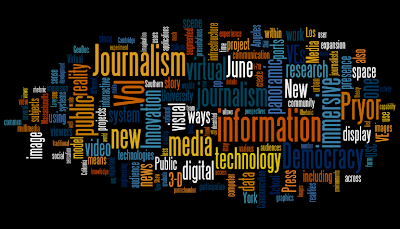Innovation Journalism Vol 6 No 5, 1 June 2009
By Larry Pryor
http://www.innovationjournalism.org/archive/injo-6-5.pdf
Virtual Environments (VEs) open new possibilities for journalism. The advanced technology, which still resides mostly in laboratories, only requires adaptation and the imagination that can enable journalists to think with technology. The literature of VE theory shows the possibility exists to create alternative worlds that invite the public to share knowledge necessary for rational policy decisions. Our research has looked at using head-mounted displays to tell news stories, and we have worked with a multi-user 360° panoramic display. A project is now under way to use immersive techniques to model port expansions in Southern California. We will also seek to find ways to distribute this visual information across individual, community and institutional audiences.
Monday, June 1, 2009
PITFALLS OF ATTENTION WORK IN THE INNOVATION ECOSYSTEM
Innovation Journalism Vol 6 No 4, 1 June 2009
By Vilma Luoma-aho, Turo Uskali and Alisa Weinstein
http://www.innovationjournalism.org/archive/injo-6-4.pdf
In this study we concentrated on the pitfalls of attention work in the innovation ecosystem of Silicon Valley by interviewing 20 journalists, analysts, entrepreneurs, investors and PR practitioners in the fall 2008. The major outcome of the research was that attention work has become harder for both professional groups of journalists and public relations practitioners in recent times. After observing the many difficulties in communicating the innovations and innovation ecosystems, what requires more extended examination here is the concrete advice of helping the flow of innovation information. This does not only mean new tools or new types of media, but new types of collaboration between the different attention workers.
By Vilma Luoma-aho, Turo Uskali and Alisa Weinstein
http://www.innovationjournalism.org/archive/injo-6-4.pdf
In this study we concentrated on the pitfalls of attention work in the innovation ecosystem of Silicon Valley by interviewing 20 journalists, analysts, entrepreneurs, investors and PR practitioners in the fall 2008. The major outcome of the research was that attention work has become harder for both professional groups of journalists and public relations practitioners in recent times. After observing the many difficulties in communicating the innovations and innovation ecosystems, what requires more extended examination here is the concrete advice of helping the flow of innovation information. This does not only mean new tools or new types of media, but new types of collaboration between the different attention workers.
FOCUS ON GROWTH: INNOVATION, THE MEDIA AND PUBLIC INTEREST
Innovation Journalism Vol.6 No.3, 1 June 2009.
by Carl-Gustav Linden
http://www.innovationjournalism.org/archive/injo-6-3.pdf
Innovation Journalism (InJo) has been promoted as a new type of media work that can be of value to stakeholders in the innovation eco-system, which means that it is mainly catering to particular interests. In some parts it resembles the “public sphere model” of Habermas. It is also presented as a business model in itself with strong links to the dominating “market model” of the media. This is limiting the scope of potential influence. Economic growth through innovations in social and physical technology is of interest to the society as a whole. This paper deals with the issue of how public interest in a larger perspective can be related to InJo. For this purpose possible stakeholders are mapped and discussed. The suggestion is that InJo can be framed as journalism dealing with long waves and the most important sources of economic growth and societal renewal.
by Carl-Gustav Linden
http://www.innovationjournalism.org/archive/injo-6-3.pdf
Innovation Journalism (InJo) has been promoted as a new type of media work that can be of value to stakeholders in the innovation eco-system, which means that it is mainly catering to particular interests. In some parts it resembles the “public sphere model” of Habermas. It is also presented as a business model in itself with strong links to the dominating “market model” of the media. This is limiting the scope of potential influence. Economic growth through innovations in social and physical technology is of interest to the society as a whole. This paper deals with the issue of how public interest in a larger perspective can be related to InJo. For this purpose possible stakeholders are mapped and discussed. The suggestion is that InJo can be framed as journalism dealing with long waves and the most important sources of economic growth and societal renewal.
Subscribe to:
Posts (Atom)



